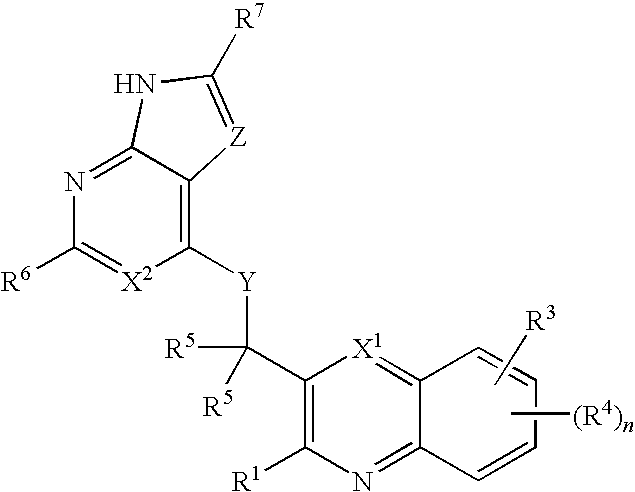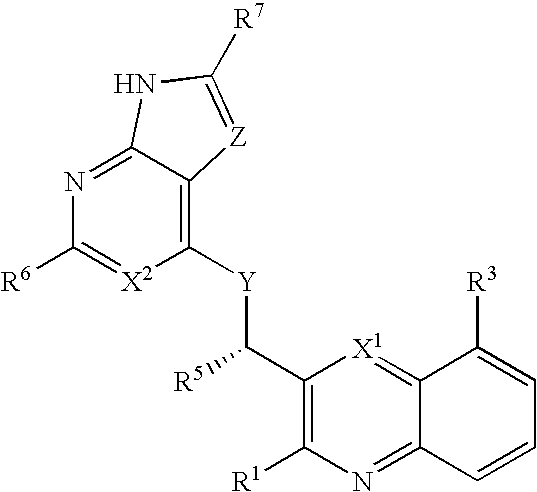Heterocyclic compounds and their uses
a technology of heterocyclic compounds and compounds, applied in the field of heterocyclic compounds and their, can solve the problems of limited utility of these compounds in studying the roles of individual class i pi 3-kinases, compounds, and non-specific pi3k inhibitors
- Summary
- Abstract
- Description
- Claims
- Application Information
AI Technical Summary
Benefits of technology
Problems solved by technology
Method used
Image
Examples
example 1
Preparation of N-((8-Methyl-2-o-tolylquinolin-3-yl)methyl)-9H-purin-6-amine
8-Methyl-2-o-tolylquinoline-3-carbaldehyde
[0167]
Prepared according to Procedure A using 2-chloro-8-methylquinoline-3-carbaldehyde (2.1 g, 10 mmol), o-tolylboronic acid (1.5 g, 1.1 eq), tetrakis(triphenyl-phosphine)palladium (575 mg, 0.05 eq), and sodium carbonate (5.5 g, 5 eq) in MeCN (75 mL) and water (25 mL). After purification, 8-methyl-2-o-tolylquinoline-3-carbaldehyde was obtained as white solid. 1H-NMR (CDCl3) 9.96 (s, 1H), 8.83 (s, 1H), 7.88 (d, J=7.8 Hz, 1H), 7.74 (d, J=6.3 Hz, 1H), 7.55 (t, J=7.8 Hz, 1H), 7.36-7.46 (m, 4H), 2.84 (s, 3H), δ 2.30 (s, 3H). Mass Spectrum (ESI) m / e=262 (M+1).
(8-Methyl-2-o-tolylquinolin-3-yl)methanol
[0168]
Prepared according to Procedure B using 8-methyl-2-o-tolylquinoline-3-carbaldehyde (1.28 g, 4.9 mmol) and solid NaBH4 (278 mg, 1.5 eq) in THF (10 mL).
[0169]After purification, (8-methyl-2-o-tolylquinolin-3-yl)methanol was obtained as white solid.
3-(Chloromethyl)-8-methyl-...
example 2
Preparation of N-((8-Chloro-2-(2-chlorophenyl)quinolin-3-yl)-methyl)-9H-purin-6-amine
2,8-Dichloroquinoline-3-carbaldehyde
[0172]
A solution of LDA (14.8 mL 1.5 M in cyclohexene, 22.2 mmol, 1.1 eq) in THF (30 mL) was stirred at −78° C. as a solution of 2,8-dichloroquinoline (4.0 g, 20.2 mmol) in THF (15 mL) was added dropwise. The mixture stirred for two hours, at which time a solution of ethylformate (6.5 mL, 80.8 mmol, 4 eq) in THF (10 mL) was added slowly, and the mixture continued to stir at −78° C. for four hours. Wet THF (1 mL H2O in 5 mL THF) was added to quench the reaction and it was warmed to room temperature. After partitioning between Et2O and water, the aqueous layer was further extracted with Et2O, and the combined organic layers were dried over MgSO4, filtered and condensed under reduced pressure. The residue was chromatographed on a silica column using a 0-50% gradient of EtOAc in hexane. 2,3-Dichloroquinoline-3-carbaldehyde was obtained as a yellow solid. 1H NMR (400 M...
example 3
Preparation of 2-Chloro-N-((8-chloro-2-(2-chlorophenyl)-quinolin-3-yl)methyl)-9H-purin-6-amine
[0178]
Prepared according to Procedure H using (8-chloro-2-(2-chlorophenyl)quinolin-3-yl)methanamine (0.100 g, 0.33 mmol), 2,6-dichloropurine (0.062 g, 0.33 mmol, 1 eq) and DIEA (0.07 mL, 0.4 mmol, 1.2 eq) in ethanol (5 mL). 2-Chloro-N-((8-chloro-2-(2-chlorophenyl)quinolin-3-yl)methyl)-9H-purin-6-amine [PI3Kδ C50=615 nM] was obtained after purification as a white solid. 1H NMR (500 MHz, DMSO-d6) δ ppm 8.44 (1H, s), 8.15 (1H, s), 8.04 (1H, dd, J=8.5, 1.2 Hz), 7.96 (1H, d, J=6.7 Hz), 7.60 (1H, d, J=7.3 Hz), 7.61 (1H, t, J=7.9 Hz), 7.54 (1H, d, J=6.7 Hz), 7.50 (1H, t, J=6.7 Hz), 7.44 (1H, t, J=7.3 Hz), 4.62 (2H, d, J=26.9 Hz) Mass Spectrum (ESI) m / e=455.0 and 457.0 (M+1)
PUM
| Property | Measurement | Unit |
|---|---|---|
| Structure | aaaaa | aaaaa |
| Chemical shift | aaaaa | aaaaa |
Abstract
Description
Claims
Application Information
 Login to View More
Login to View More - R&D
- Intellectual Property
- Life Sciences
- Materials
- Tech Scout
- Unparalleled Data Quality
- Higher Quality Content
- 60% Fewer Hallucinations
Browse by: Latest US Patents, China's latest patents, Technical Efficacy Thesaurus, Application Domain, Technology Topic, Popular Technical Reports.
© 2025 PatSnap. All rights reserved.Legal|Privacy policy|Modern Slavery Act Transparency Statement|Sitemap|About US| Contact US: help@patsnap.com



